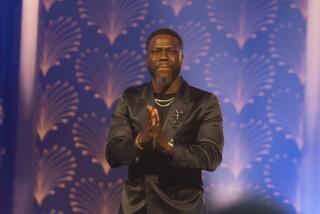The Internet Is Reshaping Bryant Story
- Share via
A small but telling moment from the Kobe Bryant media frenzy:
Earlier this week, Fox Sports Net’s Southern California Sports Report told viewers that a Denver radio station had broadcast an unconfirmed report that Bryant had a previous relationship with his accuser in the Eagle County, Colo., rape case.
The TV picture went to split screen for an analysis by a New York-based legal-affairs expert who twice within half a minute referred to the radio report as “evidence.”
Multiply that moment of imprecision and you can appreciate why the news media’s handling of the case feels chaotic and contradictory.
Speculation is coursing through the Internet, sometimes making its way onto sports talk radio, where it hardens into fact as a 10-second news update. Competitive pressure between 24-hour cable TV sports and news outlets results in prolonged conjecture about the credibility of Bryant’s accuser. Mainstream newspapers, torn between old standards and new fears of losing readers to broadcasters or cyberspace, are split over how much to tell readers about the accuser’s past. Even a hallowed media policy -- withholding the names of victims of sexual assault -- is under fire in a few quarters.
Coverage of the O.J. Simpson trial of the mid-’90s conferred newfound respectability on gossip tabloids such as the National Enquirer, which -- while sometimes paying for interviews -- broke stories that TV and daily newspapers felt obligated to follow. The line between tabloid and mainstream journalism has been blurred ever since.
In the Bryant case, the new player is the Internet.
There are about eight times as many North American Internet users -- more than 160 million -- as there were during the Simpson case. Their thirst for immediate information, and the determination of entrepreneurs to profit from it, has led to Web sites such as www.freekobe.com, where thousands argue the case and treat rumors about the 19-year-old accuser as though they were fact. (The Web site, which sells “Free Kobe” merchandise, boasts that it is making a financial donation to support “gender equity” in sports.) Sites such as www.sexcriminals.com run “Is Kobe Guilty?” polls. (“This is entertainment at its best!” one user e-mailed the site.)
For several days this week, other Web sites attracted considerable attention by publishing purported photographs and the supposed name and e-mail address of Bryant’s accuser. Then it turned out the sites had the wrong young woman -- an 18-year-old whose mother said she is an acquaintance of the accuser and has a similar first name and hair color. The family hired a lawyer to demand Web sites stop using the photos.
“The Kobe Bryant case may be a kind of watershed moment for the Internet,” said media critic and historian Neal Gabler. “I’m just astonished by it.”
Gabler said pressure from the Internet is indirectly responsible for the way a wide variety of characterizations of Bryant’s accuser have made their way into the mass media.
“The Internet has no editor, so everything gets out there. Then it gets picked up by talk radio, which also has no filtering system. Then that process puts pressure on more traditional news outlets, like local newspapers, to pick up the story because it’s out there and people are talking about it,” Gabler said. “These newspapers are in competitive situations. Once they pick it up, there is pressure on more responsible organizations to [make use of] these rumors, if not publish them as fact.”
Layers of classic elements -- rich athlete, young woman, small town, mysterious liaison, betrayed wife, shocked parents, the specter of prison -- make the Bryant case irresistible. Numerous tabloid, television and conventional news-media reporters have interviewed young people described as friends of the accuser in an attempt to examine her credibility -- a process that mirrors what Bryant’s defense team is expected to try to do in court once the case goes to trial.
However, these stories -- many of which have focused on a single friend’s description of the accuser’s mood or behavior in recent months -- have painted a contradictory picture. (In an effort to mock these stories, an editorial cartoon in the weekly Vail, Colo., Trail a week ago showed a young woman telling a cluster of TV cameras: “It’s from a reliable source. It’s from the cousin of a friend whose niece is best friends with an acquaintance of a girl who knew someone in the same class as the victim.”)
Times reporters in Colorado have made the same sort of pursuit, but the paper’s editors have imposed strict limits on what the paper will publish. The Times has carried no stories attempting to profile the accuser’s mood or behavior apart from describing the evening of June 30, when she says Bryant forced her to have sex in his hotel room, where he was staying before undergoing knee surgery. By contrast, two other Southern California daily newspapers, the Daily News and the Orange County Register, have published stories about the accuser’s background.
Times Managing Editor Dean Baquet said three considerations have shaped The Times’ decisions: First, some of the material “doesn’t meet the reporting standard,” such as the credibility of some young people who describe themselves as friends of the accuser. Second, the paper has a practice of withholding the name of an alleged sexual-assault victim as well as details of her life that could lead to her being identified. Third, in the Bryant story the paper has decided not to publish facts that are not relevant to the alleged assault, such as the behavior of the accuser.
In the opening weeks of the Simpson murder case in 1994, The Times faced a similar quandary as tabloid and other media swarmed over Los Angeles, producing a wave of fast-breaking stories about Simpson’s relationship with his wife and the background of one police detective accused of racism. The newspaper decided it would not allude to claims made by other news media unless they could be independently verified. One example was the widely reported story that police evidence against Simpson included a bloody ski mask, which The Times did not publish -- and which turned out to be untrue.
“Newspapers should be more conservative than they were 10 years ago,” Baquet said. “The Internet, the Matt Drudges, Web sites -- people can’t tell the difference any more between rumor and fact.”
Some Southern California sports talk radio hosts -- largely supportive of Bryant -- have suggested The Times is protecting the accuser by not publishing stories that might tend to question her veracity. Tom Rosenstiel, director of the Washington-based Project for Excellence in Journalism and a former Times media reporter, said the newspaper would benefit from explaining its position. “One of the things we know from a lot of polling we have done is that people usually don’t understand the motives behind the decisions that journalists make. They think we do it simply to sell more newspapers.”
Gregory Moore, editor of the Denver Post, which has published numerous characterizations of the accuser by her friends, said his paper has “a more expansive view” of what is publishable than The Times. “Just as we’ve reported aggressively about Kobe, we want to give readers reasonable information about the accuser.... She filed a rape charge against a very prominent person; that person’s life is open to scrutiny and, to a certain degree, hers is, too.”
In a radio ratings stunt, Los Angeles-based talk-show host Tom Leykis talked about the accuser -- using her real name -- this week, arguing that she deserved no more privacy than Bryant. Leykis, who builds his talk show around the premise that men are under feminist siege, said the identification came from telephoning friends of the accuser quoted in newspaper reports. “The minute you tell people we have to protect the accuser, it implies guilt on the part of the accused,” Leykis said. “It implies that there is a victim when in fact we don’t know that yet.”
Leykis’ actions offended many editors and rape-victim advocates. But a day later, Geneva Overholser, a former ombudsman of the Washington Post, said it was time for newspapers to begin covering rape victims like other crime victims.
For decades, journalists have followed the urging of victims and counselors who contend there is a stigma to being named as a rape victim. But Overholser, writing on a journalism Web site, suggested that practice has “prolonged the stigma.... And I wonder if shielding the accuser does not inflame still further the cruel search for dirt about her.”
It is hypocritical, Overholser said in an interview, to “pride ourselves on not naming rape victims and then smear them in a newspaper and claim we’re protecting them.”
Times editor Baquet said naming victims would be a wrongheaded attempt to change society’s attitude toward rape, which is not a newspaper’s job. Overholser said the original decision to suppress rape victims’ names was itself a wrongheaded attempt at social engineering that should be reversed.
The Times has departed from its policy on rare occasions when rape victims decided to come forward by name. Last year, for example, the newspaper did not identify two teenage girls who survived a sexual assault by an armed man in Lancaster, but published their names once they told their stories on television.
Overholser, who now teaches journalism at the University of Missouri, first attracted attention on the issue in 1990 when, as editor of the Des Moines Register, she campaigned against secrecy in rape cases with a five-part, Pulitzer Prize-winning series on one woman’s ordeal. Then, critical mass on the issue was not in sight, she said. “But the season is now.”
More to Read
Go beyond the scoreboard
Get the latest on L.A.'s teams in the daily Sports Report newsletter.
You may occasionally receive promotional content from the Los Angeles Times.










